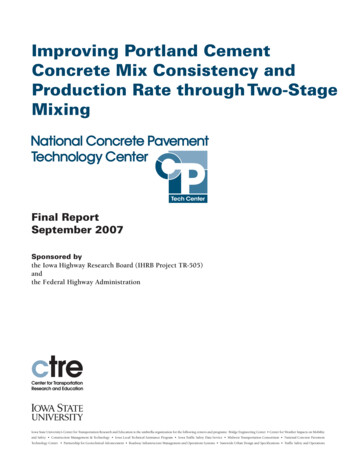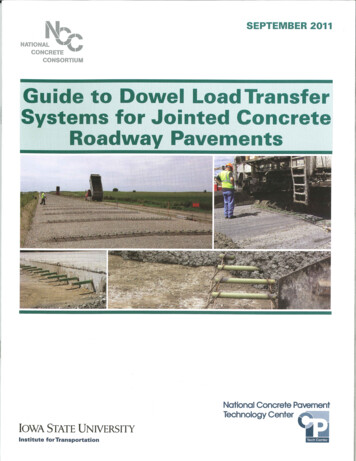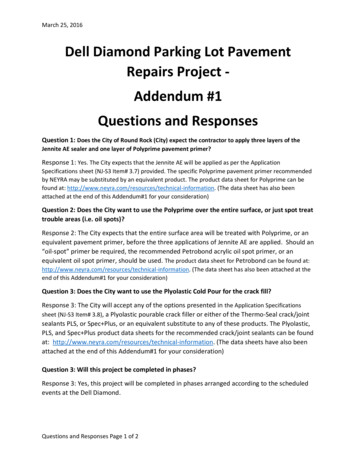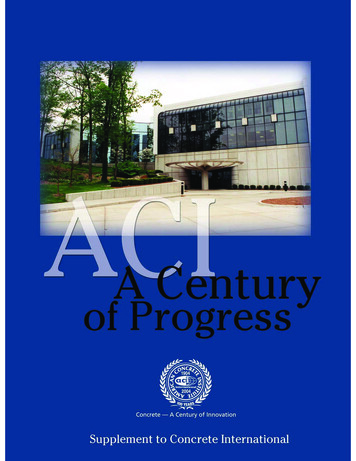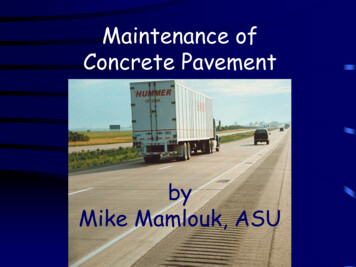
Transcription
Maintenance ofConcrete PavementbyMike Mamlouk, ASU
Overview Concept of preventivemaintenance Treatments
Concrete PavementPCC SlabSubbaseSubgrade
Jointed Plane Concrete Pavement12 to 20 ft12 to 20 ftTransverse Joints(with dowels)PLANVIEWLongitudinal Joint(with tie bars)
Example Variable Spacingand Skewed JointsTrafficTraffic10112 ft15 ft13 ft14 ft
Dowel Bars
High NeedsTypicallyLowBudget Notenough to maintaincurrent conditionsPreventiveMaintenanceCould Not enoughbeto eliminatebacklogthe Answer
Preventive Maintenance
Objective of PreventiveMaintenanceKeep the pavement conditionabove a level that wouldrequire correctivemaintenance or otherstrategies
When should a pavementpreventive maintenancetreatment be applied?
How much oil should acar burn beforechanging oil?
Pavement ConditionMaintenance TypesPreventiveCorrectiveEmergencyTime or Traffic
Candidate forPM?
Candidate for PM?
Pumping
Pumping
PumpingTravel
FaultingTravelApproachslabFaultSaturatedsupport layerWedge of“injected fines”Movementof fines
Faulting
Functions of MaintenanceTreatments Seal joints and cracks Preserve the pavementsystem Retard future deterioration
Effective PreventiveMaintenance 1.00 forpreventivemaintenance hereConditionGoodis 4 to 5 timesmore costeffective thanherePoorAge
When Should PM be ementConditionPoorDeferActionRehab.Time (Years).
Maintenance Treatments1. Joint and crack sealing2. Retrofitting of dowels3. Subsealing (undersealing)
1. JOINT & CRACK SEALING A routine maintenance activity To prevent intrusion of water incompressible materials
Warrants for Sealing % failed sealants Pavement type, pavement &sealant condition & available fund Rating numbers based on sealant& pavement condition, traffic level& climate
Effect of Not SealingWater infiltration may cause: Pumping Faulting Joint spalling/deterioration Voids under slab Corrosion of dowel and tie bars Freeze-thaw slab deterioration
Five Steps to Resealinga.b.c.d.e.Removing the old sealantShaping the reservoirCleaning the reservoirInstalling the backer rodInstalling the sealant
a. Old Sealant Removal Manual Sawing Plowing Cutting
Manual
Sawing
Plowing
Cutting
b. Shaping ReservoirAfter removing old sealant Widen as necessary (routing) Dislodge all old material
Blade for Slight Widening0.5 in.Blade0.4 in.Old SealantSawing out the old Sealant
c. Cleaning
d. InstallingBacker Rod
e. Sealing
Sealant Materials Thermoplastic materialsHot-appliedCold-applied Thermosetting materialsChemically curedSolvent release Preformed compression sealants
1. Place filler2. Place tapeseparator3. Place sealant
Preformed Compression Sealant
Lane/Shoulder Joint1 in. or greater reservoir against asphalt
Clean/Sandblast
Seal
Resealing Cracks More difficult to: Shape Clean Seal Do not expect uniform reservoir Same cleaning steps as joints May use tape instead of backer rod
Shape
Clean / Seal
Sealing Performance Reduces pumping and creationof voids Preserves pavement condition Extends pavement life
Sealing Limitations Limited to low severity cracks Not recommended for cracksextending across full lane Routing may cause spalling
2. DOWEL BAR RERPFITTING Increasingly popular method Installation of dowels to transfer load Faulted transverse joints and cracks Reduces further deterioration Pumping and faulting Spalling Corner breaks
L xU 0Poor Load TransferL xU xGood Load Transfer
Main Operations Cutting slots Cleaning and preparing slots Placing the dowel bars Backfilling the slots
Line Up Slots Parallel to CenterlineDowel SlotsCenterline
Dowel Bar Retrofit Layout36 in. or as requiredSaw cut18 in.End viewFull depth jointforming medium& dowel supportT/2TDowel bar tube1in. expansionSide viewClip chair
Backfilling
3. SUBSEALING(UNDERSEALING) Filling voids under the slab Stabilize slabs Grind to restore ride quality
Void Formation Under Slab atJoint
Void Detection Visual inspection Proofrolling with heavy equipment Deflection nondestructive testing Radar or infrared testing Epoxy and drilling method
Visual InspectionLook For: Faulted joints Stains from pumping Shoulder blow holes Corner breaks Large shoulder drop-offs Depression areas
StaticDeflectionTesting
Void Detection Using NDTDynamic Deflection Testing
Grout Materials Cement grout mixtures Pozzolanic - cement grout (mostcommon) Limestone - cement grout
DrillingInjectionHoles
Automated Drill Rig
PumpingGrout
Starting Injection
Example Grout Injection Pattern21345Push any underlying water out toward shoulders
Stop Injection When The slab begins to rise Grout no longer pumps belowthe maximum allowable pressure You see grout flowing upthrough adjacent holes
Checking Slab Lift
Final Steps Insert wooden plugs only if required Perform post testing 24-48 hoursafter stabilizing the slab redo any slabs with highdeflections consider replacing slab full-depthafter third injection
Subsealing Performance Increases structural integrity Extends pavement life Provides smooth ride Reduces faulting progression Reduces slab deflection Reduces reflection cracking
Alternative to PreventiveMaintenance Grinding Major repair Rehabilitation Reconstruction
Grinding
Major Repair
Rehabilitation
Reconstruction
State-of-the-PracticePocketGuides
Concrete Pavement . Jointed Plane Concrete Pavement 12 to 20 ft Transverse Joints (with dowels) . Manual Sawing Plowing Cutting . Manual . Sawing . Plowing . Cutting . b. Shaping Reservoir . State-of-the-Practice
